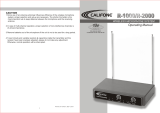
www.PyleUSA.com www.PyleUSA.com
CATALOG
1. FOREWORD --------------------------------------------------------------------------------------------- 2
2. INTRODUCTION
--------------------------------------------------------------------------------------- 2
3. SYSTEM FEATURES
----------------------------------------------------------------------------------- 2
4. SYSTEM TYPE
------------------------------------------------------------------------------------------- 2
5. FOUR CHANNEL RECEIVER FEATURES
-------------------------------------------------------- 3
6. TRANSMITTER FUNCTION & FEATURES
--------------------------------------------------- 4-5
7. TRANSMITTER BATTERY INSTALLATION
----------------------------------------------------- 6
8. BODYPACK TRANSMITTER CONNECTION
--------------------------------------------------- 7
9. SYSTEM CONNECTIONS
--------------------------------------------------------------------------- 8
10. BODYPACK TRANSMITTER AUDIO GAIN ADJUSTMENT
----------------------------- 9
11. TIPS FOR ACHIEVING MAXIMUM PERFORMANCE
------------------------------------- 9
12. TROUBLESHOOTING
----------------------------------------------------------------------------- 10
12. SPECIFICATIONS
----------------------------------------------------------------------------------- 11
SYSTEM COMPOSITION
1. Receiver
------------------------------------------------------------------------------------------------ X1
2. Wireless hand-held or body-pack microphone
---------------------------------------- X4
3. Audio Cable
------------------------------------------------------------------------------------------ X1
4. AC power adapter of special receiver
------------------------------------------------------ X1
5. Battery 1.5V
------------------------------------------------------------------------------------------ X8
6. User guide
-------------------------------------------------------------------------------------------- X1
1 2
FOREWORD
This professional wireless set provides a high quality microphone with UHF
radio system for freedom of movement without loss of audio quality. Please
read this manual before using this equipment in order to avoid damage
through incorrect operation and to get the best performance from your
purchase. This professional series wireless microphone system used an ecient
American, low consumption discharging technique with a super sensitive UHF
high broadband frequency receiver and controlled with 10ppm crystal,
matched with an independent developed mobile frequency compression,
expander circuit, image frequency limiting circuit, a multiple checked silent
and noisy circuit, switch impact noise defect circuit, resist reverberation circuit
and changed output controlled slowly etc. Designed by a computer EDA
system and nished on its item named pattern line. Every system is available to
an excellent electric function by Q.C. strictly.
INTRODUCTION
Your new wireless Series system is designed to give you the best of both sound
reinforcement worlds: the freedom of a wireless system, and the excellent
quality. This manual covers each of the Series system: The VocalArtist-UHF, The
Presenter UHF, The headset-UHF and The Guitarist-UHF.
SYSTEM FEATURES
All UHF Series systems oer a variety of exceptional features, including:
1. Simultaneous Output Use: Unbalanced 1/4' phone plug and balanced XLR
output connectors may be used simultaneously to dierent externaldevices.
2. Range: UHF Series transmitters will work at a distance of up to 50 meters
(about 164 ft.) from the receiver.
3. Noise Squelch: Squelch circuit analyzes signal strength and quality so that
can reduce the likelihood of noise burst due to environmental RF (radio
frequency) noise.
4. Low Battery Warning Light: A red light on the body-pack and hand-held
transmitters warns the user that there is less than one hour of battery Iife left.
SYSTEM TYPE
The Vocal Artist-UHF is a hand-held system designed for singers who desire
the high quality of microphones and the freedom of wireless performance.
The Presenter-UHF is a body-pack system designed for public speakers who
prefer an inconspicuous, hands-free lavalier microphone.
The Headset-UHF is a body-pack system designed for users in physically
active applications, who desire the freedom of hand-free microphone.
The Guitarist-UHF is a body-pack system designed for use with electric
guitars, basses, and other electric instruments.











